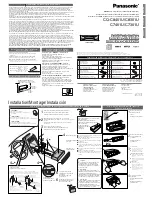
User’s Guide M-32 AD
© RME
9
4.2 Quick Start
After connection of all cables and power-on of the device, the configuration of the M-32 AD
starts in the CLOCK section. Choose a clock source and a sample rate.
Connect the TRS-jacks or the D-sub connector with the analog signal source. Change the input
sensitivity by pressing ANALOG INPUT until the input level is sufficient to avoid noisy operation.
Try to achieve an optimum input level by adjusting the source itself. Raise the source’s output
level until the red OVR LEDs flash at the loudest parts of the signal, then reduce the level a bit
until no more Overs are detected.
The analog line inputs of the M-32 AD can be accessed by using D-sub (with an optional XLR
multicore) and 1/4" TRS jacks. Both are internally connected, so not operational at the same
time. The electronic input stage is built in a servo balanced design which handles unbalanced
(mono TS) and balanced (XLR, stereo TRS jacks) correctly, automatically adjusting the level
reference.
When switched on for the first time the M-32 AD starts in a default mode which should be suit-
able for most applications:
•
AD conversion in master mode (CLOCK INTERNAL)
•
Sample rate 44.1 kHz
•
Level ref19 dBu
The M-32 AD stores all current settings and automatically activates them when the device is
turned on.
Summary of Contents for M-16 AD
Page 5: ...User s Guide M 32 AD RME 5 User s Guide M 32 AD M 16 AD General...
Page 13: ...User s Guide M 32 AD RME 13 User s Guide M 32 AD M 16 AD Usage and Operation...
Page 21: ...User s Guide M 32 AD RME 21 User s Guide M 32 AD M 16 AD Inputs and Outputs...
Page 28: ...28 User s Guide M 32 AD RME...
Page 29: ...User s Guide M 32 AD RME 29 User s Guide M 32 AD M 16 AD Technical Reference...
Page 40: ...40 User s Guide M 32 AD RME 17 Block Diagram M 32 AD...
Page 41: ...User s Guide M 32 AD RME 41 18 Block Diagram M 16 AD...
Page 47: ...User s Guide M 32 AD RME 47 User s Guide M 32 AD M 16 AD Application Examples...
Page 55: ...User s Guide M 32 AD RME 55...










































